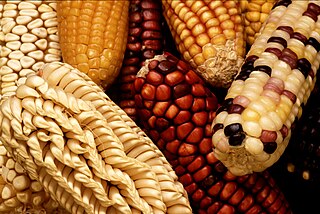
A seed bank stores seeds to preserve genetic diversity; hence it is a type of gene bank. There are many reasons to store seeds. One is to preserve the genes that plant breeders need to increase yield, disease resistance, drought tolerance, nutritional quality, taste, etc. of crops. Another is to forestall loss of genetic diversity in rare or imperiled plant species in an effort to conserve biodiversity ex situ. Many plants that were used centuries ago by humans are used less frequently now; seed banks offer a way to preserve that historical and cultural value. Collections of seeds stored at constant low temperature and low moisture are guarded against loss of genetic resources that are otherwise maintained in situ or in field collections. These alternative "living" collections can be damaged by natural disasters, outbreaks of disease, or war. Seed banks are considered seed libraries, containing valuable information about evolved strategies to combat plant stress, and can be used to create genetically modified versions of existing seeds. The work of seed banks often span decades and even centuries. Most seed banks are publicly funded and seeds are usually available for research that benefits the public.
The International Treaty on Plant Genetic Resources for Food and Agriculture is a comprehensive international agreement in harmony with the Convention on Biological Diversity, which aims at guaranteeing food security through the conservation, exchange and sustainable use of the world's plant genetic resources for food and agriculture (PGRFA), the fair and equitable benefit sharing arising from its use, as well as the recognition of farmers' rights. It was signed in 2001 in Madrid, and entered into force on 29 June 2004.

Ex situ conservation is the process of protecting an endangered species, variety, or breed of plant or animal outside its natural habitat. For example, by removing part of the population from a threatened habitat and placing it in a new location, an artificial environment which is similar to the natural habitat of the respective animal and within the care of humans, such as a zoological park or wildlife sanctuary. The degree to which humans control or modify the natural dynamics of the managed population varies widely, and this may include alteration of living environments, reproductive patterns, access to resources, and protection from predation and mortality.

The International Union for the Protection of New Varieties of Plants or UPOV is a treaty body with headquarters in Geneva, Switzerland. Its objective is to provide an effective system for plant variety protection. It does so by defining a blueprint regulation to be implemented by its members in national law. The expression UPOV Convention also refers to one of the three instruments that relate to the union, namely the 1991 Act of the UPOV Convention, 1978 Act of the UPOV Convention and 1961 Act of the UPOV Convention with Amendments of 1972.

Plant breeders' rights (PBR), also known as plant variety rights (PVR), are rights granted in certain places to the breeder of a new variety of plant that give the breeder exclusive control over the propagating material and harvested material of a new variety for a number of years.

Agricultural biodiversity or agrobiodiversity is a subset of general biodiversity pertaining to agriculture. It can be defined as "the variety and variability of animals, plants and micro-organisms at the genetic, species and ecosystem levels that sustain the ecosystem structures, functions and processes in and around production systems, and that provide food and non-food agricultural products.” It is managed by farmers, pastoralists, fishers and forest dwellers, agrobiodiversity provides stability, adaptability and resilience and constitutes a key element of the livelihood strategies of rural communities throughout the world. Agrobiodiversity is central to sustainable food systems and sustainable diets. The use of agricultural biodiversity can contribute to food security, nutrition security, and livelihood security, and it is critical for climate adaptation and climate mitigation.

Germplasm refers to genetic resources such as seeds, tissues, and DNA sequences that are maintained for the purpose of animal and plant breeding, conservation efforts, agriculture, and other research uses. These resources may take the form of seed collections stored in seed banks, trees growing in nurseries, animal breeding lines maintained in animal breeding programs or gene banks. Germplasm collections can range from collections of wild species to elite, domesticated breeding lines that have undergone extensive human selection. Germplasm collection is important for the maintenance of biological diversity, food security, and conservation efforts.

A gene bank is a type of biorepository that serves to preserve the genetic information of organisms. Gene banks are often used for storing the genetic material of species that are endangered or close to extinction. They are also used for the preservation of major crop species and cultivars, in order to preserve crop diversity.

The Crop Trust, officially known as the Global Crop Diversity Trust, is an international nonprofit organization with a secretariat in Bonn, Germany. Its mission is to conserve and make available the world's crop diversity for food security.

Bioversity International is a global research-for-development organization that delivers scientific evidence, management practices and policy options to use and safeguard agricultural biodiversity to attain global food- and nutrition security, working with partners in low-income countries in different regions where agricultural biodiversity can contribute to improved nutrition, resilience, productivity and climate change adaptation. In 2019, Bioversity International joined with the International Center for Tropical Agriculture to "deliver research-based solutions that harness agricultural biodiversity and sustainably transform food systems to improve people's lives". Both institutions are members of the CGIAR, a global research partnership for a food-secure future.

A crop wild relative (CWR) is a wild plant closely related to a domesticated plant. It may be a wild ancestor of the domesticated (cultivated) plant or another closely related taxon.
Crop diversity or crop biodiversity is the variety and variability of crops, plants used in agriculture, including their genetic and phenotypic characteristics. It is a subset of a specific element of agricultural biodiversity. Over the past 50 years, there has been a major decline in two components of crop diversity; genetic diversity within each crop and the number of species commonly grown.
Forest genetic resources or foresttree genetic resources are genetic resources of forest shrub and tree species. Forest genetic resources are essential for forest-depending communities who rely for a substantial part of their livelihoods on timber and non-timber forest products for food security, domestic use and income generation. These resources are also the basis for large-scale wood production in planted forests to satisfy the worldwide need for timber and paper. Genetic resources of several important timber, fruit and other non-timber tree species are conserved ex situ in genebanks or maintained in field collections. Nevertheless, in situ conservation in forests and on farms is in the case of most tree species the most important measure to protect their genetic resources.
Genetic resources are genetic material of actual or potential value, where genetic material means any material of plant, animal, microbial or other origin containing functional units of heredity. Genetic resources is one of the three levels of biodiversity defined by the Convention on Biological Diversity in Rio, 1992.
The Nordic Genetic Resource Center is a plant, farm animal and forest conservation, gene resource guardian, and sustainable use organization under and primarily financed by the Nordic Council of Ministers, and is headquartered in Alnarp, near Malmö, in southern Sweden. NordGen's primary mission is "securing the broad diversity of genetic resources linked to food and agriculture" through "conservation and sustainable use, solid documentation and information work and international agreements".

Animal genetic resources for food and agriculture (AnGR), also known as farm animal genetic resources or livestock biodiversity, are genetic resources of avian and mammalian species, which are used for food and agriculture purposes. AnGR is a subset of and a specific element of agricultural biodiversity.
The National Centre for Plant Genetic Resources: Polish Genebank (NCPGR) is a research unit in the Plant Breeding and Acclimatization Institute – National Research Institute. NCPGR is the coordinator and implementer of the National Crop Plant Genetic Resources Protection Programme. The Programme aims to protect the biodiversity of crop plants endangered by genetic erosion in Poland, and is funded by the Ministry of Agriculture. The main tasks include collection of crop and wild plant populations and varieties threatened by genetic erosion, description and evaluation of collected materials, and preservation of their viability and genetic purity. The Programme is an implementation of provisions laid down in international treaties ratified by Poland:
Genetic resources means genetic material of actual or potential value where genetic material means any material of plant, animal, microbial or other origin containing functional units of heredity... Genetic resources thus refer to the part of genetic diversity that has or could have practical use, such as in plant breeding. The term was introduced by Otto Frankel and Erna Bennett for a technical conference on the exploration, utilization and conservation of plant genetic resources, organized by the Food and Agriculture Organisation (FAO) and the International Biological Program (IBP), held in Rome, Italy, 18–26 September 1967.
Digital sequence information (DSI) is a placeholder term used in international policy fora, particularly the Convention on Biological Diversity (CBD), to refer to data derived from dematerialized genetic resources (GR).

Geoffrey Hawtin OBE is an agricultural scientist and World Food Prize laureate who has served in public institutions working in agricultural biodiversity, plant genetic resources, crop breeding and research management. He was awarded an OBE by Queen Elizabeth II and has been recognized for his career "dedicated to using agriculture as a weapon in the war against poverty in developing countries." He played key roles in the creation of the Svalbard Global Seed Vault and the negotiation of the International Treaty on Plant Genetic Resources. He has headed two CGIAR Research Centers and currently is on the Executive Board of the Crop Trust.












